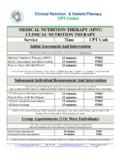Transcription of Chemical Composition of Living Cells - Teton …
1 Chapter 1 Chemical Composition of Living Cells2 All Living organisms, from microbes to mam-mals, are composed of Chemical substancesfrom both the inorganic and organic world, thatappear in roughly the same proportions, andperform the same general tasks. Hydrogen,oxygen, nitrogen, carbon, phosphorus,andsulfurnormally make up more than 99% of themass of Living Cells , and when combined invarious ways, form virtually all known organicbiomolecules. They are initially utilized in thesynthesis of a small number of building blocksthat are, in turn, used in the construction of avast array of vital macromolecules (Fig 1-1).There are four general classes of macromol-ecules within Living Cells : nucleic acids,proteins, polysaccharides,and lipids. Thesecompounds, which have molecular weightsranging from 1 x 103to 1 x 106, are createdthrough polymerization of building blocks thathave molecular weights in the range of 50 to150.
2 Although subtle differences do existbetween Cells ( , erythrocyte, liver, muscleor fat cell), they all generally contain a greatervariety of proteins than any other type ofmacromolecule, with about 50% of the solidmatter of the cell being protein (15% on a wet-weight basis). Cells generally contain manymore protein molecules than DNA molecules,yet DNAis typically the largest biomolecule inthe cell. About 99%of cellular molecules arewatermolecules, with water normallyaccounting for approximately 70% of the totalwet-weight of the cell. Although water isobviously important to the vitality of all livingcells, the bulk of our attention is usuallyfocused on the other 1% of in Table 1-1regarding the chemicalcomposition of the unicellular Escherichia coli(E.)
3 Coli), are not greatly different for multicel-lular organisms, including mammals. Each , and similar bacterium, contains a singlechromosome, therefore, it has only one uniqueOverview Hydrogen, oxygen, nitrogen, carbon, sulfur, and phosphorus normally makeup more than 99% of the mass of Living Cells . Ninety-nine percent of the molecules inside Living Cells are water molecules. Cells normally contain more protein than DNA. Homogenous polymers are noninformational. All non-essential lipids can be generated from acetyl-CoA. Like certain amino acids and unsaturated fatty acids, various inorganic elements are dietarily "essential". Most all diseases in animals are manifestations of abnormalities in biomolecules, Chemical reactions, or biochemical pathways. 14 Amino Acid and Protein Metabolism3 DNA molecule.
4 Mammals, however, containmore chromosomes, and thus have differentDNA molecules in the Acids Nucleic acids are nucleotide polymers (fromthe Greek word poly, meaning "several", andmer, meaning "unit"), that store and transmitgenetic information. Only 4 different nucleotidesare used in nucleic acid biosynthesis. Geneticinformation contained in nucleic acids isstored and replicated in chromosomes, whichcontain genes(from the Greek word gennan,meaning "to produce"). A chromosome is adeoxyribonucleic acid (DNA) molecule, andgenes are segments of intact DNA. The totalnumber of genes in any given mammalian cellmay total several thousand. When a cell repli-cates itself, identical copies of DNA moleculesare produced, therefore the hereditary line ofdescent is conserved, and the genetic informa-tion carried on DNA is available to direct theoccurrence of virtually all Chemical reactionswithin the cell.
5 The bulk of genetic informationcarried on DNA provides instructions for theOOHO-CH2-OPOOOOHHOOHOHCH2 OHCH3(CH2)14 COOH(Palmitic Acid)NucleotidesH2 NCHRA mino acidsCOHHCCH3CH3CH3 HOCH2CH2CH2 CCH3CH3 HOCA cetyl CoASCoAH3 COSimple Sugars( Glucose)B1B2B3B4R1R2R3R4 NUCLEIC ACIDSPROTEINSPOLYSACCHARIDES(Cholesterol )B = N-Containing BaseR = Side ChainBLIPIDSF ormation of Macromolecules Within CellsHydrogen, Oxygen, Nitrogen,Carbon, Phosphorus, SulfurFigure 1-1 Approximate Chemical Composition of a Rapidly Dividing Cell (E. coli)Different Kinds of Material% Total Wet acidsDNA11 RNA 6 Ribosomal 3 Transfer40 Messenger1000 Nucleotides and acids and 3200(Carbohydrates and metabolites)Lipids and metabolites250 Inorganic ions120(Major minerals and trace elements) of virtually every protein moleculewithin the cell.
6 The flow of information fromnucleic acids to protein is commonly repre-sented as DNA > messenger ribonucleicacid (mRNA) > transfer RNA (tRNA) >ribosomal RNA (rRNA) > protein, whichindicates that the nucleotide sequence in agene of DNA specifies the assembly of anucleotide sequence in an mRNA molecule,which in turn directs the assembly of the aminoacid sequence in protein through a tRNA andrRNA Proteins are amino acid polymers respon-sible for implementing instructions containedwithin the genetic code. Twenty differentamino acidsare used to synthesize proteins,about half are formed as metabolic intermedi-ates, while the remainder must be providedthrough the diet. The latter group is referred toas "essential" amino acids (see Chapter 3).
7 Each protein formed in the body, unique in itsown structure and function, participates inprocesses that characterize the individuality ofcells, tissues, organs, and organ systems. Atypical cell contains thousands of differentproteins, each with a different function, andmany serve as enzymes that catalyze (orspeed) reactions. Virtually every reaction in aliving cell requires an enzyme. Other proteinstransport different compounds either outsideor inside Cells { , lipoproteins and transferrin(an iron-binding protein) in plasma, or bilirubin-binding proteins in liver Cells }; some act asstorage proteins ( , myoglobin binds andTable 1-1 Data from Watson JD: Molecular Biology of the Gene, 2nd ed., Philadelphia, PA: Saunders, Composition of Living Cells4 14 Amino Acid and Protein Metabolism5stores O2in muscle Cells ); others as defenseproteins in blood or on the surface of Cells ( , clotting proteins and immunoglobulins);others as contractile proteins ( , the actin,myosin and troponin of skeletal muscle fibers);and others are merely structural in nature ( ,collagen and elastin).
8 Proteins, unlike glycogenand triglyceride, are usually not synthesizedand stored as nonfunctional Polysaccharides are polymers of simplesugars ( , monosaccharides). (The termsaccharide is derived from the Greek wordsakchar, meaning "sugar or sweetness".) Somepolysaccharides are homogeneous polymersthat contain only one kind of sugar ( ,glycogen), while others are complex heteroge-nous polymersthat contain 8-10 types ofsugars. In contrast to heterogenous polymers( , proteins, nucleic acids, and some poly-saccharides), homogenous polymersareconsidered to be "noninformational". Polysac-charides, therefore, can occur as functionaland structural components of Cells ( , glyco-proteins and glycolipids), or merely as nonin-formational storage forms of energy ( ,glycogen).
9 The 8-10 monosaccharides thatbecome the building blocks for heterogenouspolysaccharides can be synthesized fromglucose, or formed from other metabolic inter-mediates (see Chapter 20). Lipids Lipids (from the Greek word lipos, meaning"fat") are naturally occurring, nonpolarsubstances that are mostly insoluble in water(with the exceptions being the short-chainvolatile fatty acids and ketone bodies), yetsoluble in nonpolar solvents (like chloroformand ether). They serve as membrane compo-nents (cholesterol, glycolipids and phospho-lipids), storage forms of energy (triglycerides),precursors to other important biomolecules(fatty acids), insulation barriers (neutral fatstores), protective coatings to prevent infectionand excessive gain or loss of water, and somevitamins (A, D, E, and K) and hormones (steroidhormones).
10 Major classes of lipids are thesaturated and unsaturated fatty acids (short,medium, and long-chain), triglycerides,lipoproteins { , chylomicrons (CMs), very lowdensity (VLDL), low density (LDL), intermediatedensity (IDL), and high density lipoproteins(HDL)}, phospholipids and glycolipids, steroids(cholesterol, progesterone, etc.), andeicosanoids (prostaglandins, thromboxanes,and leukotrienes). All lipids can be synthesizedfrom acetyl-CoA, which in turn can be generatedfrom numerous different sources, includingcarbohydrates, amino acids, short-chain volatilefatty acids ( , acetate), ketone bodies, andfatty acids. Simple lipidsinclude only those thatare esters of fatty acids and an alcohol ( ,mono-, di- and triglycerides). Compound lipidsinclude various materials that contain othersubstances in addition to an alcohol and fattyacid ( , phosphoacylglycerols, sphin-gomyelins, and cerebrosides), and derivedlipidsinclude those that cannot be neatly classi-fied into either of the above ( , steroids,eicosanoids, and the fat-soluble vitamins).








